More and more, we’re hearing about the importance of magnesium. Among other things, the essential mineral is beneficial for reducing inflammation, improving sleep, and even repairing DNA. “Magnesium participates in many of the physiological functions of the body,” confirms nutritionist Itziar Digon.
While you can certainly take magnesium supplements, it’s an even better to get it the old fashioned way: by eating a magnesium-rich diet filled with fruits and vegetables. One food that’s an especially excellent source? Spinach. Not only is spinach filled with magnesium, but it can be cooked in many ways without lowering the nutritional quality of the mineral. Nutritionist Paula Martin Clares notes that the leafy green is great for the “health of the skin, hair, and bones because—in addition to magnesium—it contains calcium, iron, potassium, phosphorus, B vitamins, and vitamins A ,C, E, and K.”
Why is everyone so obsessed with magnesium?
Much like vitamin D—which has also been receiving plenty of attention lately—magnesium is one of the nutrients many of us generally lack. However, we need it: magnesium is involved in hundreds of functions. “It keeps the muscles and immune system in good condition,” Digón explains to us, noting that it can also reduce fatigue.
Isabel Viña Bas, resident doctor of endocrinology and nutrition at the supplement brand IVB Wellness Lab explains further: “Magnesium is the second most abundant mineral within each of our cells. Its role in the body is ubiquitous, as it is needed for more than 300 metabolic reactions, two of the most important being correct muscle contraction and relaxation (including blood vessels and the heart) as well as correct nerve transmission.” However, studies confirm that many people are magnesium deficient, with common symptoms that include muscle heaviness, insomnia, and fatigue.
Magnesium in spinach
Spinach is a tried-and-true superfood for a reason—it’s low in calories (just 7 calories per cup) yet rich in antioxidants that protect the liver, colon, and eyes. As the doctor Olivier Courtin-Clarins notes in his book Beauty In My Recipes, spinach also promotes digestive well-being thanks to its high fiber content.
Magnesium, which also has bowel-stimulating properties, can aid in detoxing the body as well. With 24 mg of magnesium per cup of raw spinach, eating the green is a win-win for keeping everything running smoothly.
Is it better to eat spinach raw or cooked?
Leafy green vegetables like spinach can be eaten raw or cooked since cooking does not destroy magnesium—in fact, the magnesium in spinach actually increases after cooking; cooked spinach contains 157 mg of magnesium. “While it’s true that cooked vegetables lose a certain amount of water-soluble vitamins, the capacity of the body to absorb minerals such as magnesium, iron, and calcium is actually increased after cooking since the molecular structure changes to become more bioavailable,” explains Digón. To that end, she recommends eating cooked spinach at night to aid digestion and absorption for a good night’s sleep.
Easy ways to include spinach in your diet
With that in mind, there are a variety of ways that spinach can be added to the diet. Try spinach as the base of salad accompanied by any type of ingredient. Courtin-Clarins, for example, advises combining spinach with cherry tomatoes, olive oil, and white wine vinegar to create a simple salad. For extra nutrients, include a serving of protein such as chicken, turkey, tuna, and a small amount of healthy fats like walnuts or avocado.

